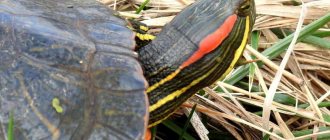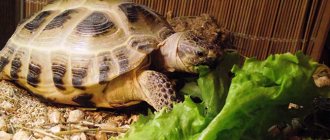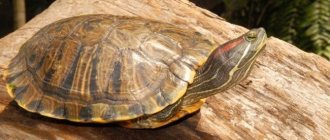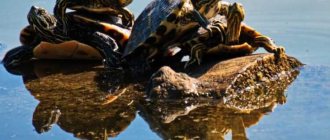Description of the red-eared turtle
The wrinkled shell of an adult red-eared turtle can reach a length of 28 cm and a weight of 2.8 kg, depending on the subspecies. The spot behind their eyes is not only bright red, but also bright yellow. In general, the colors of these turtles are extremely diverse, and in addition, they change greatly with age. Young animals are usually bright green, but older ones can turn completely black. The plastron of red-eared turtles is bright yellow with dark round spots. Male ornamental turtles have a long tail and long claws, no notch on the plastron, and a slightly more pointed nose than females. Females have short claws and a short tail. Females (18-22 cm) are usually larger than males (14-16 cm). During the first 1.5 years of life, they are able to grow up to 7.5 cm, then growth slows down and the turtle grows 1-1.25 cm per year. In the first 2 years, a turtle is quite capable of growing to 20 cm or more, i.e. the turtle is not dwarf or decorative, as sellers often convince naive buyers of. Trachemys scripta scripta - Length up to 27 cm. Has a very noticeable yellow postorbital patch connected to a stripe on the neck. Each costal scute of the carapace has a yellow stripe. The plastron is yellow with spots on most of the front scutes. Trachemys scripta elegans - Length up to 28 cm. There is a wide red postorbital stripe on the head and narrow stripes on the chin. On each costal carapace there is a transverse yellow stripe. Plastron with a large spot on each scute. Trachemys scripta troostii - Length up to 21 cm. The head has a narrow yellow postorbital stripe and wide chin stripes. Each costal carapace has a yellow transverse stripe. Plastron with a pattern of “eyes” or small black spots.
How to keep your animal healthy
Most often, diseases occur due to poor care and feeding. Be sure to monitor the cleanliness of the water, because various microbes can develop in the water, affecting the health of the animal. To keep your pet healthy you need to:
- Sick pets are kept at a temperature of 27-30 degrees. At this time, it will be better if he spends most of the time in the water.
- If your pet is a poor swimmer, lower the water level in the aquarium. But keep in mind that she should easily crawl ashore.
- If you suspect an infection, isolate your pet. Wash your hands well after handling it.
- If you doubt that you can cure your pet, contact your veterinarian.
Habitat
Red-eared turtles are found in the area from southern Virginia to northern Florida and Kansas, Oklahoma and New Mexico in the west (USA), Mexico, all of Central America, northwestern South America (northern Colombia and Venezuela). The species is introduced to the south of Florida, Arizona, Guadeloupe, Israel and South Africa and a number of other countries. Turtles live in small lakes and ponds with low, swampy shores.
Diet of the red-eared slider
Young red-eared or yellow-eared turtles require more animal food for active growth, so they are fed animal food daily, but once a day. Adult turtles (larger than 7 cm or older than 1-1.5 years) are fed animal food every 2 or 3 days. On other days you can feed with plant foods. You must choose the amount of food yourself, depending on how much the turtle eats. Usually for babies the volume of food is 2-3 pieces of 1 cm3, for older adults - 2-3 pieces of 2-3 cm3, or as much as the turtle eats in half an hour. Food for red-eared turtles should be raw and at room temperature. You cannot feed turtles only gammarus or dry food, this is not food for a predator!
Types of food in equal parts: FISH (lean river whole with bones and entrails), LIVER (beef liver, chicken heart, beef heart), INSECTS and CRUSTACEANS (daphnia crustaceans, gammarus (raw or frozen), bloodworms, earthworms, crickets, locusts without legs, zofobas), OTHERS (small freshwater snails, green shrimp, tadpoles, mollusks, frogs, small mice, occasionally seafood can be given). Vegetable food can be aquatic plants (duckweed, water hyacinth, pistia, hornwort, etc.), as well as meadow grasses that are non-toxic to turtles (dandelion, clover, plantain, mallow, damselfish, squash), or store-bought salads, thin layers of carrots. Dry food can be part of the diet only if it is in granules and from foreign companies (Tetra, Sera, JBL). In an aquarium you can keep food fish (guppies, barbs, neons and others), snails and aquatic plants with turtles, but all this will be eaten quite quickly.
Do not feed: meat (any minced meat, sausages, beef, pork, lamb, chicken, etc.), fatty fish, fruits, bread, cheese. Read more... In the presence of ultraviolet radiation and the necessary conditions (including temperature) in an aquaterrarium with the correct balanced food, the turtle does not necessarily need vitamin and calcium supplements. However, if the diet is not fully thought out and the conditions are not ideal, the turtle must receive vitamins and calcium. To do this, the food is sprinkled with calcium and vitamins and fed from tweezers. So that the turtle can sharpen its beak and get additional calcium, it is also better to put a cuttlefish bone (sepia) in the aquarium for birds.
What to feed your pet
Red-eared turtles are omnivores, eating only in water. To keep them healthy, feeding must be varied. This can be special food for turtles (Tetra ReptoMin, JBL Agil, Sera Reptil Professional Carnivor, Zoomir Tortila-M), vegetables, some aquarium plants, fish, various insects. Juveniles are given more protein food, while adults, on the contrary, are given vegetable food.
All turtles, without exception, love to eat live small fish, such as guppies, zebrafish, fry of other fish, as well as snails. But such food should be given rarely. To keep your shell strong, include calcium in your diet. Calcium is contained in required quantities in specialized feeds. Feed with a mixture of fresh vegetables several times a week. Good food would be duckweed, riccia, ludwigia, lettuce, dandelion, cucumber and zucchini scalded with boiling water.
The frequency of feeding depends on the size of the pet. Juveniles up to one year old are fed every day. After a year, food is given every other day.
Keeping a red-eared turtle in captivity
An aquaterrarium of 50 liters for young turtles and 200 liters for one or two adults, where 1/3 should be dry land. Equipment: water heater, filter, thermometer, shore Lighting: 40-60 W incandescent lamp, ultraviolet lamp for reptiles 10-12% UVB.
Turtles spend a lot of time in the sun. The UVI range for them is 1.8-3 average, 3.7-8.45 maximum (3-4th Fergusson zone). Daylight hours in summer - 13 hours, in winter - 11 hours. The daytime air temperature is 25-30 C with the temperature under the lamp (at the heating point) 35 C, and the night temperature is 22 C. In winter it is 22-25 C.
An aquaterrarium for a red-eared turtle can be low, not very wide, but it must be long, with a volume of about 120–150 liters for one adult turtle (minimum 120 liters). The water level should be at least the width of the turtle's shell (i.e. at least 10 cm), which will allow it to roll over if for any reason it ends up on its back. The aquarium must have a shore or land with a gently sloping ladder leading to it. It is advisable not to make land out of stones, as the turtle may hit them with its shell, which will cause bruises and other injuries. The water temperature in the aquarium is from 20 to 24°C, the air temperature on the shore is about 31–33°C. The difference between the temperature of the water and the air on the shore should be approximately 10 C. To maintain the water temperature, you need an aquarium water heater, however, if the water temperature is normal without a heater, then there is no need for it. The water in the aquarium must be changed as it gets dirty, partial water changes must be done regularly, and a powerful filter must be used (internal for young turtles, external for adult turtles). The filter should be designed for a volume of water that is 2-3 times the amount of water poured into your aquarium. If the water in the aquarium is too warm (more than 25 C), the turtle most likely will not come ashore. If it is too cold (below 20), the turtle will sit on land all the time.
An incandescent lamp and an ultraviolet lamp for reptiles should be installed above the island at a height of at least 20–25 cm to prevent burns. Both lamps should burn for 10-12 hours a day, at night they must be turned off manually, or use a timer. Turtles usually bask on land, where they receive ultraviolet radiation necessary for activity, good metabolism (digestion of food and stomach function) and prevention of rickets (softening of bones and shells). It is advisable that the lamps do not shine on the water. In the summer, you can organize a pond for the turtle at the dacha, but it must be fenced with a high fence, as the turtle can escape. You can keep a turtle outside at temperatures above 20 C.
German herpetologists recommend using the following temperatures to keep turtles throughout the year. The heater is only used if the desired temperature is not achieved by the season alone. It is not necessary to adhere to these recommendations, but it is advisable, especially for adults. For Trachemys scripta scripta and Trachemys scripta elegans:
| Month | Temperature | Duration of illumination |
| April | 21 | 8 |
| May | 24 | 10 |
| June | 27 | 13 |
| July | 28 | 13 |
| August | 28 | 11 |
| September | 25 | 10 |
| October | 22 | 8 |
| November-March | 18 | 8 |
for Trachemys scripta troostii:
| Month | Temperature | Duration of illumination |
| April | 20 | 8 |
| May | 21 | 10 |
| June | 23 | 13 |
| July | 26 | 13 |
| August | 25 | 11 |
| September | 20 | 10 |
| October-March | 18 | 8 |
Decoration features
When decorating an aquarium, you should remember safety - this is the main principle of selecting decorations. You should not use objects in the decor that could injure your pet. Sharp corners and edges are unacceptable.
When decorating an aquarium, you should remember safety - this is the main principle of selecting decorations.
Do not use soil that is too fine, as animals may swallow it. Such soil becomes dirty faster, and cleaning it is not the easiest process. It is preferable to take pebbles in a fraction of 5-6 cm.
For small individuals, you can plant green plants. Adult turtles no longer need soil, and they can eat plants. As for fish, it is appropriate to introduce them only to young reptiles.
Plastic plants will also help you decorate your aquarium. They are attached to the ground using weights. You can also install artificial silk vines on dry land areas. Here's how to decorate your pet's house:
- pebbles;
- grottoes;
- driftwood.
As for the latter, it is not recommended to take too fresh driftwood, as they will release harmful substances. It is advisable to use pieces of wood that have been lying in a body of water for a long time.
Reproduction of red-eared turtles
Red-eared turtles become sexually mature in nature at 6–8 years of age, and in captivity at 4 (males) and 5–6 years for females. In March or April, the mating season begins: each male, having met a female, manages to end up right in front of her face, and very close. The female swims forward, and the male swims backward, tickling the female’s chin with his long claws. The eggs of red-eared turtles are no larger than 4 centimeters. To lay them, the female leaves the reservoir and comes to land. Having found a suitable place, she heavily wets the ground with water from the anal bladders. After this, it begins to dig a hole with its hind legs - a nest. The nests of red-eared turtles look like a ball with a diameter of 7 to 25 centimeters, in which females lay 5–22 (6–10) eggs, which they then bury. Incubation temperature is from 21°C to 30°C and duration is 103–150 days. At incubation temperatures below 27°C, males hatch, and at temperatures above 30°C, only females hatch.
In captivity, red-eared turtles can lay eggs without a male (unfertilized fat eggs). You can feed them to the turtle itself or simply throw them away. Broken eggs greatly spoil the water in the aquarium.
Arrangement of the island
The reptile spends a lot of time on the shore, so you can safely equip several areas of land. Each animal should have a separate island. One should be placed in the shade, and the other in a bright place. While on land, the reptile receives an ultraviolet tan. When arranging islands, it is important to listen to the following recommendations:
- The shore should rise smoothly from the bottom; steep cliffs are unacceptable. You can leave a ladder or a small ladder, use a large stone or a grotto with gentle walls.
- The surface of the sushi must be made rough, it must be made of high quality materials.
- For several turtles, you will need a large area so that they can be on land at the same time and fit freely there.
- If there are many islands, then some of them may be covered with water by several millimeters.
To prevent reptiles from escaping, you need to place dry land 30 cm below the edge of the aquarium.
The reptile spends a lot of time on the shore, so you can safely equip several areas of land.
Additionally
The lifespan of red-eared turtles is from 30 to 45 years. Unfortunately, ornamental turtle hatchlings have a high mortality rate, usually due to poor maintenance by their owners. In nature, turtles grow on average 1.5 cm per year. They must also grow in captivity, which is achieved by proper nutrition. Fishermen search for clutches and use turtle eggs as excellent bait for fish. Young turtles are captured in untold quantities (especially in the Mississippi Valley) and transported to pet stores throughout the United States. Turtles are often aggressive and can bite both people and other turtles. Red-eared turtles, accustomed to being handled, often do not bite. Red-eared turtles do not get along well with marsh turtles in the aquarium and often bite off their tails.
How to warm the shore
The temperature on the island is 30-35 degrees comfortable for animals. They control it with a thermometer. The lamp should be placed so that the turtle does not get burned from it. If you have several pets, you should know that they can climb on top of each other and get warm at the same time. In this case, the lamps are installed higher. It is also worth remembering that when turtles get into the water, splashes fly, so the lamp is covered to prevent water from entering. Turn on the heating for 10-12 hours.
The lamp should be taken with UV rays. They buy it at a pet store. Without UV rays, the animal will not be able to absorb calcium, will begin to get sick and will become ugly.
A few photo examples of an aquarium for turtles:











